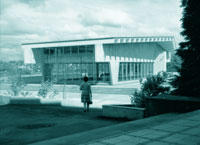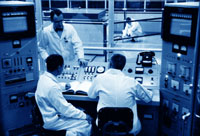
For almost three decades, the University of Washington was home to the most obscure nuclear reactor operating in the state. Installed in 1961, the tiny reactor was used solely for research and teaching purposes in the Department of Nuclear Engineering.
What was unique about the UW's reactor was the design of its building, located next to Moore Hall near the skybridge to Hec Edmuneson Pavilion. The walls were made of glass, allowing spectators to look in on the reactor, which appeared to be a collection of large, metal boxes approximately the size of a garden shed.
According to Albert Babb, the founding chair of the nuclear engineering department, the observatory-style design was the brainchild of Harold Wessman, dean of the graduate school. "It was the only reactor in the world with glass windows," says Babb, who helped design the reactor. "It was the dean's idea that the public should not be made nervous, that they should be able to look in."

During the years of nuclear experiments that followed, there was only one incident that caused concern about exposure to radiation. In 1972, doctoral candidate Robert Sloan, '73, was conducting an experiment that involved radioactive plutonium. The experiment was designed to improve the safety of reactors, but ironically resulted in a minuscule amount of radioactive dust being released into the air.
"The material we were working with was in an aluminum foil, and the foil broke," says Sloan. "There were radiation monitors running all the time. The UW also had staff that monitored the facilities. That was when the leak was detected."
No serious injuries resulted from the leak but the reactor was immediately shut down for six weeks while experts conducted tests to discover the severity of contamination within the facility.

Perhaps of more concern to the general public than radiation was the threat of the reactor's reliance on high-grade uranium. During the years between the establishment of the nuclear engineering department in 1965 and the program's official elimination in 1992, there was a growing concern that the small amount of uranium used in the reactor could find its way into unfriendly hands and be used to construct a bomb.
"[Protestors] questioned the security of reactors," recalls Babb. "The materials would be scary in the hands of terrorists." He says the university considered cementing around the glass windows of the reactor building, but opted for shutting the reactor down instead.
The reactor officially ceased activity in 1988. Although the fuel rods-the most hazardous part of a reactor-were removed more than 20 years ago, the decommissioning will not be complete until the entire building has been demolished and the rubble removed from campus. The UW finally received state funds last year to finish dismantling the reactor, which will bring the university into compliance with an order the Nuclear Regulatory Commission issued in 1995. In two years, no trace of the reactor will remain.
There are only six research reactors active on university campuses today, a significant decline from the 25 operating in 1985. More than 30 years after his upsetting experience with the plutonium leak in the UW reactor, Sloan says that the loss of research activity bothers him. "Obviously, reactors are going to play an important part in the future," he says. "I think it is probable that there has been a loss of a whole generation-maybe two generations-of technology."
—Amy Rolph